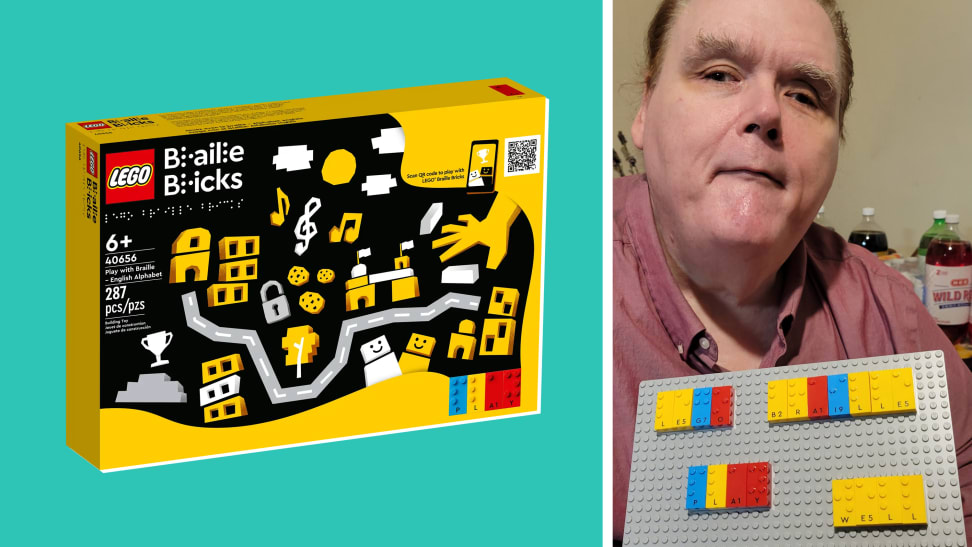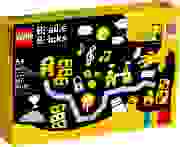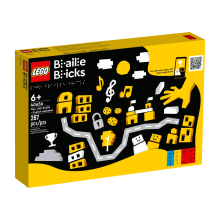Lego Braille Bricks Review
These Braille Legos we tested help kids with vision loss learn an essential skill


 Credit:
Reviewed / Maxwell Ivey / Lego
Credit:
Reviewed / Maxwell Ivey / Lego
Products are chosen independently by our editors. Purchases made through our links may earn us a commission.
-

Lego Braille Bricks Play with Braille – English Alphabet
Pros
-
Large and universal use
-
Fun and copious online activities
Cons
-
Packaging easily damaged
-
Shapes lack variety for building
-
Be My Eyes help is not truly independent
-
As a 57-year-old man who’s legally blind, when I was asked to review Braille Legos, I thought, maybe I’m too old to play with kids’ toys. But I was quickly reminded of something my dad used to say: “Adults are just kids over 48 inches tall.”
With this assignment, I intend to channel my inner child as much as possible. As you’ll see from the photos below, I thought the great Fred Rogers would be a solid source for inspiration, though my red sweater is, admittedly, not nearly as suave as his.
While I grew up in the era of Lincoln Logs and Tinker Toys, far before Legos, I have some experience using building toys as a kid. Lego Braille Bricks, which first became available for educational use in 2020 and were released to the wider public in 2023, have the potential to not just teach those with visual disabilities an unfortunately ignored skill, they also offer children with sight more opportunities to include those who may need visual assistance.
Would I be able to freely build to my heart’s content? Are these Legos truly as inclusive as they sound? That’s what this Lego Braille Brick review aims to find out.
About Lego Braille Bricks
Why are Braille Legos so important?


Lego Braille Bricks launched in 2020 but were made available for the public in 2023. Do they deliver on their inclusive promises?
Before I comment on the Legos themselves, I should explain why the concept of Braille Legos is so potentially important. As many folks in the disability community can attest to, our population is often both underemployed and underpaid.
For those who are visually impaired specifically, research suggests a large point of developmental hindrance comes from not learning to read at a young age. If this skill isn't stressed early on, it can impact one’s prospects for higher education and earning a living wage later in life.
Many modern schools of thought suggest the advent of video descriptions and screen reading technology negate the need for Braille, but, in the wider world, it’s still actively used.
Those impacted by disabilities should seek every chance to better manage their condition. Learning Braille is one such skill. The fact that these bricks help teach Braille, and are now widely available, is hugely important because even those who may be shy about their vision loss can benefit from them.
How do Lego Braille Bricks work?


Through numerous activities and a partnership with Be My Eyes, Lego Group has made Braille Bricks a fairly flexible product.
In design, Lego Braille Bricks aren’t vastly different from their traditional counterparts. The main difference is that the bricks feature the Braille alphabet, along with text equivalents, printed as the large studs on the top of each brick. For example, the set features a brick with studs shaped in the Braille character for the letter P that also has a large text letter P printed on it.
There are more than 250 bricks in the set, made in five colors: red, yellow, green, blue, and white. The package also has two base plates to build on top of and a key that illustrates which colors each Braille character corresponds to.
For those who need assistance building, Lego has partnered with the Be My Eyes app to provide live instruction from sighted individuals for those who need it when using this Lego set or any others. Select Specialized Help, Games and Toys, and then Lego Group to be directly connected to a specialist during certain hours.
What I like about Lego Braille Bricks
The Lego bricks are large and universally appealing


The Lego Braille Bricks set comes with 287 pieces that mesh well with any existing Legos you may have.
While the stud shapes may be unique, it’s worth stressing again that these Legos work and attach just fine with any other Legos you may have around the house. That means anyone can actively enjoy and use them.
When it comes to learning Braille, I like that the bricks themselves are so large. For young minds and small hands, these large bricks can really help anyone actively learning the characters get a strong sense of their tactile feel. Their plastic surface also makes them more durable than paper and, thus, easier to read.
The online activities are fun
To help kids learn through play, the Lego Braille Bricks set directs players to a link with six Braille-specific activities called Play Starters.
- Hand of the Giant: A two-player game where one player, the giant, puts their hand on a base station. The other player tries to build around the player’s hand without touching it.
- Land of Two Cities (Level 1): Build two small buildings on opposite ends of the base plate, with a road connecting them.
- Race to the Top (Level 1): Players must compete to build a hotel. Draw a random block and count its studs. The number of studs dictates how many floors can be built. The first to build a hotel with 10 floors wins.
- Rock, Paper, Scissors: Each player picks an R block, a P block, and an S block. Put your hand under the table and pick the letter that corresponds to your selection.
- Master of Music (Level 1): Create a band name and write it in bricks at the bottom of the base plate. Take a random brick and assign it a sound. Place it in the top-left corner of the base plate. Add more bricks, and assign more sounds, until there are at least five. Run your finger over the bricks and repeat the sequence of sounds.
- Operation Code Breaker (Level 1): Find a brick with only one stud and place it on the top-left corner of the base plate. Find a brick with two studs and place it next to the first. Keep going like this till you reach the fifth brick with five studs.
Each activity on the site has a short description and video to assist with instruction, and video thumbnails include the proper alt text for screen readers. I especially like that the narrator of these videos encourages kids to create their own rules for each game once they’ve mastered the basics.
Of these activities, I liked Rock, Paper, Scissors and Master of Music best. I made a sign that says “Braille Legos” on one line, with “play well” below it. Play well is the translation of the word Lego.
In case this curriculum isn’t enough, the Lego Braille Bricks website features nearly 100 different activities users can try. Each activity has been designed by educators to fuse reading, language, and tactical recognition skills into a single task. These are a great tool not just for a visually impaired audience, but they also take family members’ desire to learn or teach into account as well.
Between full-fledged online courses and groups on Facebook, YouTube, and an official blog, the level of community support around a single product meant for a niche audience is outstanding.
I will say, however, that pesky messages about accepting cookies and occasional missing alt text may cause issues for blind users on official Lego websites. These aren’t dealbreakers, but they hinder what should be a flawless accessibility experience.
What I don’t like about Lego Braille Bricks
The packaging is less than ideal


As much as I loved using the product itself, the Lego Braille Bricks' packaging left something to be desired.
While parts of the packaging are nice, there are some small details that could use additional consideration. For example, when I first received my box, some of the embossed Braille on the surface of the cardboard was already damaged. In that case, then, I would suggest putting that info on a card inside the box and adding some extra padding to a surface that’s bound to get damaged through handling.
I was also frustrated by the fact that the Braille version of the brick key was placed underneath all the bricks instead of being on top, so the user can be acquainted with everything as soon as the product’s being opened.
There’s not enough variety in sets or shapes
While Lego has done an impressive job supporting Braille Bricks with unique activities, the fact that the entire set of bricks is just one size and shape limits how much you can actually build with them.
And that reality is made all the more frustrating given that this is the only Braille Lego set on the market. That’s like giving someone a pair of skis and telling them they can never go on anything but the bunny slopes, while they know their friends are flying down real mountains. Obviously this is a solid start, but I’d love to see more advanced sets for teens and adults, too.
Be My Eyes is an incomplete solution
Lego’s partnership with Be My Eyes is a solid idea, but having a sighted person assist you in the building process isn’t exactly an ideal way to get the full Lego experience. Plus, the fact that it’s only available Monday through Friday between 10 a.m. and 4 p.m. local time means kids who are in school mostly can’t take advantage of it.
That said, because the emphasis with Braille Bricks specifically is slightly more focused on manipulation than actual building, it’s possible this service may be more useful to teens or older adults who’d like to use it to create more complex models.
In the era of QR codes and barcodes, I also wonder if there might be a way to allow users to scan each brick with their phone to reveal its name in a set, size, shape, and color. Combined with digital Braille instructions, the process could be a lot more independent.
Should you buy Lego Braille Bricks?
Yes, if learning Braille is the primary goal


If learning is the primary goal, Lego Braille Bricks make an awesome purchase.
Lego Braille Bricks are worthy of praise for quite a few reasons. The fact that such a large company is willing to invest so much into teaching an underrated skill is hugely commendable.
This is a valuable educational tool that can make learning Braille fun. It allows those with visual impairment to enjoy the toys their friends are playing with in a way everyone can understand. And, while Be My Eyes isn’t a perfect alternative to independent builds, it does offer a way for anyone to use and experience this product without help.
When I told my friends I was going to be reviewing Braille Legos, many of them were jealous. That’s not a reaction I’m used to getting from most people. Even after I told them it was just a kids’ toy and that I’m not going to be building a Star Wars X-wing, Barbie dream house, or cartoon monster, they still thought it was cool.
So, not only can Braille Legos be fun and educational, but using them can also give you a chance to feel like one of the cool kids. For this 57-year-old-man, it was an experience worth having.


This Lego set helps younger people with visual impairment learn to read Braille. With hundreds of games to play, there’s a nearly limitless supply of fun.




